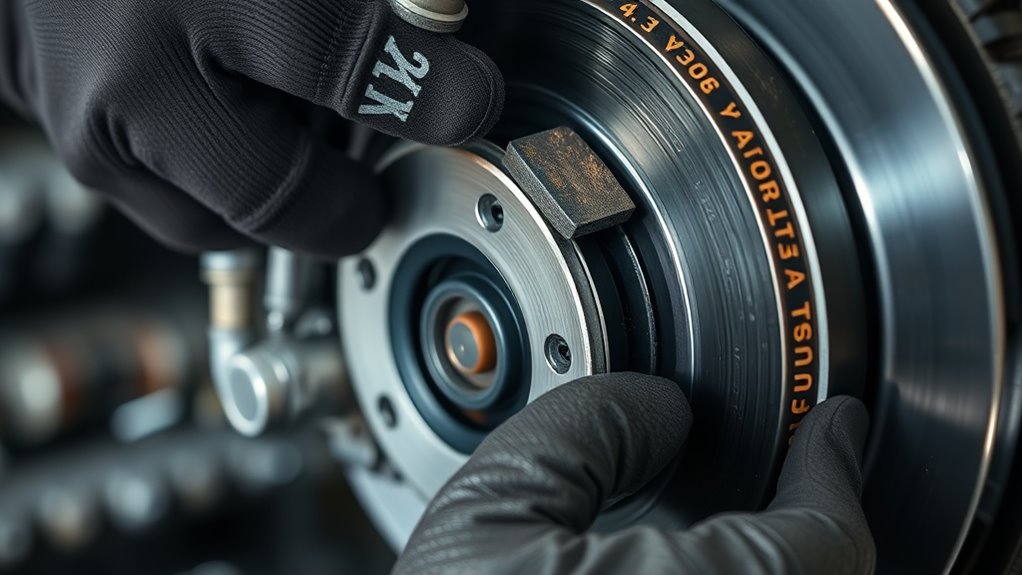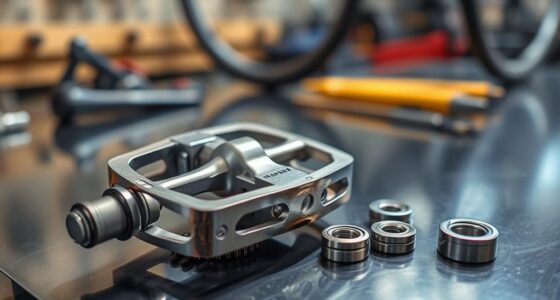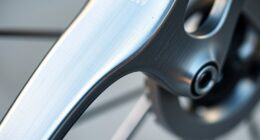To replace disc brake pads, start by safely lifting your vehicle and removing the wheel. Then, detach the caliper bolts and carefully lift the caliper away from the rotor, avoiding damage to the brake line. Remove the old pads, inspect the rotor for damage, and clean everything thoroughly. Install new pads, ensure they’re properly aligned and seated, then reassemble. Pushing the brake pedal a few times helps optimize performance. Keep learning for detailed steps and tips.
Key Takeaways
- Remove the wheel, caliper, and old brake pads carefully, inspecting the rotor for damage or irregularities.
- Choose the appropriate brake pad material based on driving habits and vehicle specifications.
- Clean the caliper and hardware, then install the new pads ensuring proper alignment and seating against the rotor.
- Resurface or replace the rotor if it is scored, grooved, or warped to ensure optimal braking performance.
- Pump the brake pedal several times after installation to properly seat the pads and verify brake functionality.

When your vehicle’s brake performance declines or you notice squealing noises, it’s time to replace the disc brake pads. Brake pad material plays a critical role in how well your brakes work and how long they last. Different materials, such as organic, semi-metallic, or ceramic, offer varying levels of durability, noise, and heat resistance. Organic pads tend to be quieter and softer but may wear out faster, while semi-metallic pads handle heat better and provide stronger stopping power. Ceramic pads, on the other hand, generate less dust and noise, but they can be pricier. Choosing the right brake pad material depends on your driving habits and your vehicle’s specifications.
Before you swap out the brake pads, it’s essential to assess the condition of your disc rotor. The disc rotor’s condition directly influences braking performance and safety. If the rotor surface is scored, grooved, or warped, simply replacing the pads might not be enough. Warped rotors can lead to pulsating brakes and uneven wear, which compromises your stopping ability. In such cases, you may need to resurface or replace the rotors altogether. A smooth, even rotor surface ensures that the new brake pads seat properly and deliver ideal braking power. Neglecting rotor condition can lead to premature pad wear or even brake failure. Regular inspection and maintenance help prevent such issues.
Assess rotor condition to ensure effective braking and prevent premature pad wear or brake failure.
When replacing the brake pads, you’ll first need to remove the wheel and locate the caliper. Once you’ve gained access, remove the caliper bolts and carefully lift the caliper away from the rotor. Be cautious not to damage the hydraulic brake line. Remove the old pads from the caliper and inspect the rotor for any damage or irregularities. If the rotor looks uneven or has deep grooves, consider resurfacing or replacing it. Before installing the new pads, clean the caliper and hardware to prevent debris from affecting braking performance. When mounting the new brake pads, ensure they are aligned correctly and seated properly against the rotor surface.
During installation, always double-check that the brake components are secure and free of debris. Once you’ve installed the new pads, pump the brake pedal a few times to seat the pads against the rotor surface properly. This step ensures consistent brake response and helps prevent pulsation. Remember, choosing the right brake pad material and keeping an eye on the disc rotor condition are key to maintaining safe, effective braking. Regular inspections and timely replacements safeguard your vehicle’s braking system, giving you peace of mind on every drive.
Frequently Asked Questions
How Often Should Brake Pads Be Replaced?
You should replace your brake pads when their lifespan reaches about 30,000 to 70,000 miles, but it varies based on driving habits. Pay attention to signs of wear like squealing noises, reduced braking performance, or a vibrating brake pedal. Regular inspections help you catch these issues early, ensuring your brakes stay effective and safe. If you notice any signs of wear, don’t delay—timely replacement keeps your vehicle safe.
Can I Replace Brake Pads Myself?
Sure, you can attempt DIY maintenance, but replacing brake pads isn’t exactly a walk in the park. Imagine juggling fiery torches while riding a unicycle—pretty risky, right? You might save money, but if you ignore brake pad lifespan and mess up, you’ll be risking your safety. So, unless you’re confident, it’s smarter to leave this to the pros. Your brakes, after all, are what keep you from turning your car into a crash test dummy.
What Tools Are Needed for Replacing Brake Pads?
You’ll need basic tools like a socket set and a C-clamp for caliper removal and brake rotor inspection. Start by loosening the caliper bolts, then remove the caliper to access the pads. Use the C-clamp to compress the piston, making room for new pads. Don’t forget to inspect the rotor for wear or damage before installing the new brake pads. These tools make the process smoother and safer.
How Do I Know if My Brake Pads Are Worn Out?
Think of brake pads as the heartbeat of your stopping power. During brake pad inspection, look for warning signs of wear like thinning pads, squealing noises, or a spongy brake pedal. If your brake pads are less than a quarter inch thick, it’s time to act. When you notice these signs, it’s a clear signal that your brake pads are worn out, and replacing them will keep your ride safe and smooth.
Are Ceramic Brake Pads Better Than Organic?
Ceramic brake pads are generally better than organic ones because they offer longer ceramic longevity and better heat resistance. You’ll notice they produce less dust and are quieter during braking. Organic performance, on the other hand, is often more affordable and provides good initial braking feel. If you want durability and cleaner brakes, ceramic pads are the way to go. However, for budget-friendly and softer braking, organic pads may suffice.
Conclusion
Replacing your disc brake pads is like giving your car a fresh set of shoes—you’ll feel the difference as you hit the road. With a little effort, you can keep your stopping power sharp and your drives safe. Think of it as tending to your vehicle’s health; regular maintenance keeps everything running smoothly. So, stay attentive, follow the steps, and enjoy the confidence that comes with well-maintained brakes. Your car will thank you with every confident stop.








